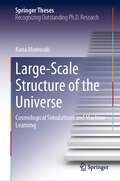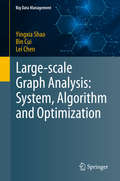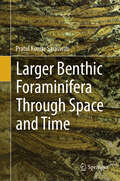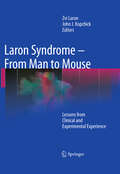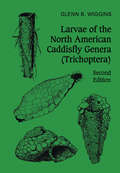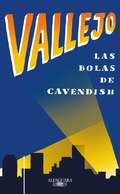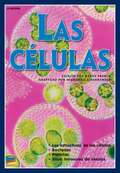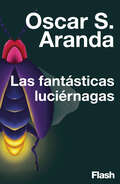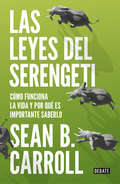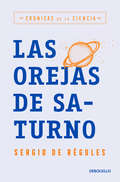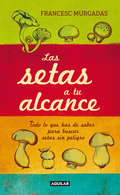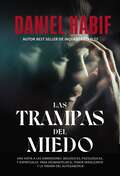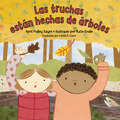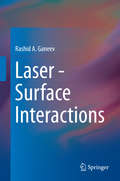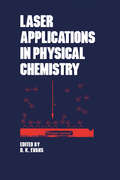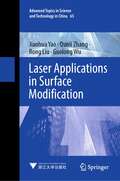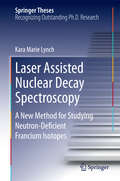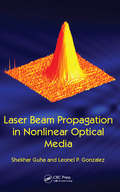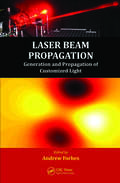- Table View
- List View
Large-Scale Scientific Computing
by Ivan Lirkov Svetozar MargenovThepapersinthis volumewerepresentedatthe4thInternationalConferenceon Large-Scale Scienti'c Computations ICLSSC 2003. It was held in Sozopol, B- garia, June 4-8, 2003. The conference was organized and sponsored by the C- tral Laboratory for Parallel Processing at the Bulgarian Academy of Sciences. Support was also provided from the Center of Excellence "BIS 21" (funded by the European Commission), SIAM and GAMM. A co-organizer of this tra- tional scienti'c meeting was the Division of Numerical Analysis and Statistics of the University of Rousse. The success of the conference and the present volume in particular are the outcome of the joint e'orts of many colleagues from various institutions and organizations. First thanks to all the members of the Scienti'c Committee for their valuable contribution to forming the scienti'c face of the conference, as well as for their help in reviewing contributed papers. We would like to specially thank the organizers of the special sessions: R. Blaheta, N. Dimitrova, A. Ebel, K. Georgiev, O. Iliev, A. Karaivanova, H. Kosina, M. Krastanov, U. Langer, P. Minev, M. Neytcheva, M. Sch] afer, V. Veliov, and Z. Zlatev. We are also grateful to the sta? involved in the local organization. Special Events: - The conference was devoted to the 60th anniversary of Raytcho Lazarov. - During the conference, the nomination for the World Level of the Hall of Fame for Engineering, Science and Technology, HOFEST, was o'cially awarded to Owe Axelsson.
Large-Scale Structure of the Universe: Cosmological Simulations and Machine Learning (Springer Theses)
by Kana MoriwakiLine intensity mapping (LIM) is an observational technique that probes the large-scale structure of the Universe by collecting light from a wide field of the sky. This book demonstrates a novel analysis method for LIM using machine learning (ML) technologies. The author develops a conditional generative adversarial network that separates designated emission signals from sources at different epochs. It thus provides, for the first time, an efficient way to extract signals from LIM data with foreground noise. The method is complementary to conventional statistical methods such as cross-correlation analysis. When applied to three-dimensional LIM data with wavelength information, high reproducibility is achieved under realistic conditions. The book further investigates how the trained machine extracts the signals, and discusses the limitation of the ML methods. Lastly an application of the LIM data to a study of cosmic reionization is presented. This book benefits students and researchers who are interested in using machine learning to multi-dimensional data not only in astronomy but also in general applications.
Large-scale Graph Analysis: System, Algorithm and Optimization (Big Data Management)
by Bin Cui Lei Chen Yingxia ShaoThis book introduces readers to a workload-aware methodology for large-scale graph algorithm optimization in graph-computing systems, and proposes several optimization techniques that can enable these systems to handle advanced graph algorithms efficiently. More concretely, it proposes a workload-aware cost model to guide the development of high-performance algorithms. On the basis of the cost model, the book subsequently presents a system-level optimization resulting in a partition-aware graph-computing engine, PAGE. In addition, it presents three efficient and scalable advanced graph algorithms – the subgraph enumeration, cohesive subgraph detection, and graph extraction algorithms. This book offers a valuable reference guide for junior researchers, covering the latest advances in large-scale graph analysis; and for senior researchers, sharing state-of-the-art solutions based on advanced graph algorithms. In addition, all readers will find a workload-aware methodology for designing efficient large-scale graph algorithms.
Larger Benthic Foraminifera Through Space and Time
by Pratul Kumar SaraswatiForaminifera are single-celled marine organisms, usually less than a millimeter in size, and their fossil records extend back in geological time some 500 million years. Some foraminifera have grown to over 10 centimeters; these are informally called "larger benthic Foraminifera" (LBF). LBF are of outstanding value in field and in laboratory experiments. They can serve as geochemical proxies and can be used to learn about biology, biomineralization process, and more. Their study finds wide-ranging geological applications, including the carbonate platforms' past environmental changes and stratigraphy. There are many books on micropaleontology, fewer on Foraminifera and practically none on LBF. The ones that do exist are generally too specialized for micropaleontology and carbonate sedimentology doctoral students to utilize. This volume aims to fill this gap by providing readers with an understanding of the morphology and distribution of LBF in space (environment) and time (evolution). In addition, the isotope and trace metal proxies in LBF are discussed for paleoclimate reconstruction. This volume will benefit researchers and professionals in micropaleontology, hydrocarbon exploration, carbonate sedimentology, and paleoclimate.
Laron Syndrome - From Man to Mouse
by Zvi Laron J. KopchickLaron syndrome (LS), or primary growth hormone (GH) insensitivity, was first described in 1966. Since then, many patients worldwide have been diagnosed with LS, which involves defects in the GH receptor that cause combined congenital deficiency of GH and IGF-I activities. In this comprehensive book the authors draw upon 50 years of multidisciplinary clinical and investigative follow-up of the large Israeli cohort of LS patients. The genetic basis of the syndrome is fully considered, and all aspects of the pathophysiology of IGF-I deficiency are described. Data derived from the recently generated mouse model of LS are reviewed and compared with the human LS experience. Valuable advice is provided on treatment, and treatment effects, such as metabolic effects, adipose tissue alterations, and impact on aging, are fully explored. Together, this book condenses, consolidates, compares, and contrasts data derived from the human and mouse LS experiences and provides a unique resource for clinical and basic scientists to evaluate and compare IGF-I and GH actions.
Larvae of the North American caddisfly genera (trichoptera)
by Glenn B. WigginsCaddisflies are one of the most diverse groups of organisms living in freshwater habitats, and their larvae are involved in energy transfer at several levels within these communities. Caddisfly larvae are also remarkable because of the exquisite food-catching nets and portable cases they construct with silk and selected pieces of plant and rock materials.This book is the most comprehensive existing reference on the aquatic larval stages of the 149 Nearctic genera of Trichoptera, comprising more than 1400 species in North America. The book is invaluable for freshwater biologists and ecologists in identifying caddisfly in the communities they study, for students of aquatic biology as a guide to the diverse fauna of freshwater habitats, and for systematic entomologists as an atlas of the larval morphology of Trichoptera.In the General Section, the biology of caddisfly larvae is considered from an evolutionary point of view. Morphological terms are discussed and illustrated and a classification of the Nearctic genera is given. Techniques are outlined for collecting and preserving larval specimens and for associating larval with adult stages. The Systematic Section begins with a key to larvae of the 26 families of North American Trichoptera. Each chapter in this section is devoted to a particular family, providing a summary of biological features and a key to genera, followed by a two-page outline for each genus with illustrations facing text. This outline provides information on general distribution, number of species, distinctive morphological features, and biological data including construction behaviour.An important feature of the book is the habit illustrations of larvae and cases of a selected species in each genus, along with illustrations of details of significant morphological structures. Each generic type is thus presented as a recognizable whole organism adapted in elegant ways to particular niches of freshwater communities.This revised edition includes advances in knowledge on the classification and biology of Trichoptera up to 1993 - an interval of 17 years since the first edition. An additional eight families and thirteen genera are included for the first time. Through reorganization of the families into three suborders, a biological context has been established for the systematic section.
Las bolas de Cavendish
by Fernando VallejoEl polémico Fernando Vallejo habla sobre ciencia en este ensayo que no dejará indiferente a nadie. En Las bolas de Cavendish se violan todas las leyes delUniverso: desde la equivalencia de la masa y la energía o Ley de Einstein hasta la Tercera Ley de Newton. Unosprofesores de la U de A y sus undergraduates, acalorados en la polémica pero muy orgullosos de que su universidad figure en el ranking de las universidades del mundo en el puesto 1550, se adentran en los misterios del cosmos. Vallejo, el fundador de la nueva ciencia de la imposturología, nos exhorta en este librito sin pretensiones a aumentar el caos que postula la Segunda Ley de la Termodinámica, la del desorden creciente que rige al mundo. Todavía no es el apocalipsis. Pero ya casi
Las enseñanzas secretas de las plantas: La inteligencia del corazón en la percepción directa de la naturaleza
by Stephen Harrod BuhnerRevela el uso de la percepción directa en la comprensión de la naturaleza, las plantas medicinales, y la sanación de las enfermedades humanas • Explora las técnicas utilizadas por los pueblos aborígenes y occidentales para aprender directamente de las propias plantas, incluidas las técnicas de Henry David Thoreau, Goethe, y Masanobu Fukuoka, autor de The One Straw Revolution [La revolución de una brizna de paja] Todos los pueblos antiguos y aborígenes afirman que sus conocimientos sobre remedios botánicos provienen de las propias plantas y no de la experimentación a través de pruebas y errores. El autor Stephen Harrod Buhner explora minuciosamente esta modalidad de cognición holística basada en el corazón a través de la obra de Luther Burbank, quien cultivó la mayoría de las plantas alimenticias que ahora consumimos sin pensar en su procedencia, y del gran poeta y científico alemán Goethe. Los lectores obtendrán los medios necesarios para recopilar información directamente del corazón de la naturaleza, aprender los usos medicinales de las plantas diagnosticar enfermedades, y comprender el proceso de creación de alma que se engendra mediante esa profunda conexión con el mundo.
Las estrellas (¡Arriba la Lectura!, Level P #16)
by Phillip Simpson Melissa WebbNIMAC-sourced textbook
Las estrellas del cielo (¡Arriba la Lectura!, Level F #36)
by Aurora GarcíaNIMAC-sourced textbook. ¿Te gustaría aprender sobre las estrellas del cielo? ¡Puedes hacer unas estrellas de papel!
Las fantásticas luciérnagas
by Oscar S. ArandaOscar S. Aranda desvela los secretos que se esconden tras la luz de las luciérnagas. A través de los recuerdos, el autor de El lenguaje secreto de la naturaleza nos invita a descubrir el luminoso sistema de comunicación de las luciérnagas. Unos insectos que frecuentemente se han comparado con las hadas y que se han visto obligados a adaptarse de formas sorprendentes a la contaminación lumínica actual.
Las leyes del Serengeti: Cómo funciona la vida y por qué es importante saberlo
by Sean B. CarrollUna síntesis ambiciosa e inspiradora escrita por uno de los mejores biólogos y más talentosos narradores. Las leyes del Serengeti es el primer libro que expone cómo funciona la vida a escalas tan diferentes. Después de leerlo, nunca verás el mundo de la misma manera. ¿Cómo funciona la vida? ¿Cómo logra la naturaleza producir la cantidad adecuada de cebras y leones en la sabana africana, o de peces en el mar? ¿Cómo produce nuestro cuerpo el número adecuado de células para nuestros órganos? En Las leyes del Serengeti el premiado biólogo Sean B. Carroll cuenta la historia de los pioneros científicos que buscaron la respuesta a estas preguntas tan sencillas como fundamentales, y muestra hasta qué punto sus descubrimientos son importantes para nuestra salud y para la salud del planeta. Una de las revelaciones más importantes sobre la naturaleza es que todo está regulado: hay leyes que regulan la cantidad de cada molécula de nuestros cuerpos como la cantidad de animales y plantas en la Tierra. Y la revelación más sorprendente acerca de las leyes que regulan la vida a escalas tan distintas es que son muy similares; la vida tiene una lógica común subyacente. Carroll explica cómo nuestro profundo conocimiento de las leyes y la lógica del cuerpo humano ha acelerado la llegada de medicamentos revolucionarios, y plantea la fascinante propuesta de que es hora de aplicar las leyes del Serengeti para sanar a nuestro achacoso planeta. Críticas:«Las leyes del Serengeti es un libro maravilloso escrito por un científico de primera clase. Desde las moléculas hasta los ecosistemas, explica con autoridad y elegancia porqué la biología moderna es fundamental no solo para la vida humana sino para el propio planeta.» Edward O. Wilson, Universidad de Harvard «Original, provocador y bellamente escrito, el libro de Carroll permite vislumbrar lasleyes profundas de la biología que gobiernan el planeta.» Siddhartha Mukherjee, autor de El gen «En Las leyes del Serengeti, el autor va de las bacterias a los elefantes para presentar las reglas básicas que configuran tanto de lo que nos rodea y lo que nos compone.» Wall Street Journal «En este libro realmente fascinante Carroll argumenta persuasivamente que la vida en todos los niveles se autorregula, desde el funcionamiento interno de las células a las más amplios relaciones que gobiernan el ecosistema del Serengeti. Carroll ilustra magistralmente los principios biológicos y ofrece enseñanzas importantes.» Publishers Weekly «Una lectura apasionante repleta de grandes y ambiciosas ideas.»Nature «Un estimulante desafío a los preceptos establecidos.» Kirkus «Sean B. Carroll es uno de nuestros mejores escritores científicos. Este es un libro visionario.» The Guardian
Las orejas de Saturno (Crónicas de la ciencia #Volumen)
by Sergio De RégulesUn compendio de amenos ensayos que nos permiten acercanos a la ciencia de la mano de uno de los divulgadores científicos más imporantes de México. Después de publicar El sol muerto de risa, querido lector, lanzamos esta colección de ensayos cuyo tema central es la ciencia y todos sus recovecos: cómo se hace, quién la hace, qué historias hay detrás, ello sin que Sergio de Régules abandone en ningún momento el sentido del humor que lo caracteriza. Vayan estas páginas con un fulgor de frescura que muchas veces imploran temas tan apasionantes, luego de ser tratados por muchos años con innecesaria seriedad.
Las plantas necesitan agua (¡Arriba la Lectura!, Level K #43)
by Heather HammondsTanto los humanos como los animales dependen de las plantas para alimentarse. Por eso, es importante que las plantas reciban suficiente agua. ¿Cómo obtienen las plantas el agua que necesitan para sobrevivir? NIMAC-sourced textbook
Las plumas (Spanish Edition): No son sólo para volar
by Melissa Stewart¡Edición en español! Los jóvenes amantes de la naturaleza y los entusiastas de los álbumes de recortes se deleitarán con esta introducción a los muchos usos de las plumas. Este libro ilustrado de no ficción, informativo, exhaustivo y extraordinario, dirigido a niños de 6 a 9 años, es el acompañante ideal para aquellos que aman las aves y explorar el aire libre.Spanish language edition! Budding nature-lovers and young scrapbook enthusiasts will be delighted by this introduction to the many uses of feathers.This informative, thorough, and extraordinary nonfiction picture book for ages 6-9 is a perfect companion for kids that love birds and exploring the outdoors.Los jóvenes naturalistas exploran dieciséis aves en esta elegante introducción a los muchos usos notables de las plumas.Un texto principal conciso destaca cómo las plumas no son sólo para volar. Los lectores más curiosos están invitados a profundizar con recuadros informativos en las páginas que subrayan cómo las plumas de todas las formas y tamaños ayudan a las aves a enfrentar el frío o el calor, protegerse del sol, nadar, planear e incluso cavar.Con una variedad de especies comunes y exóticas, los lectores se sentirán atraídos tanto por lo nuevo como por lo familiar. Las hermosas y delicadas ilustraciones en acuarela muestran plumas a tamaño real y las comparan con objetos cotidianos.Con un diseño de álbum de recortes, Las plumas es, por un lado, un diario científico y, por el otro, un libro de no ficción para leer en voz alta, lo que lo convierte en un recurso maravilloso para estudios de la naturaleza y una delicia para los amantes de las aves más jóvenes.Young naturalists explore sixteen birds in this elegant introduction to the many remarkable uses of feathers.A concise main text highlights how feathers are not just for flying. More curious readers are invited to dig deeper with informative sidebars that underscore how feathers of all shapes and sizes help birds with warming or cooling, protect them from the sun, help them swim, glide or even dig.With a range of common and exotic species readers will be engaged by both the new and the familiar. Beautiful and delicate watercolor illustrations showcase life-size feathers and compare them to everyday objects.With a scrapbook design, Feathers is part science journal, part read-along nonfiction, making it a wonderful resource for nature studies and a delight for the youngest bird lovers.
Las setas a tu alcance
by Murgadas, FrancescDescubre las variedades de setas, cómo identificarlas, cómo cocinarlas y conviértete en un experto micólogo. ¿Eres de los que sale al monte a buscar setas? ¿O prefieres adquirirlas en el supermercado? ¿Sabes reconocer las setas más preciadas? ¿Podrías identificar cuáles son venenosas? ¿Te gustaría saber cómo se cocinan? ¿Qué pasos hay que seguir para que conserven todo su sabor? El biólogo y catedrático en Ciencias Naturales Francesc Murgadas, experto en cocina, nos ofrece en Las setas a tu alcance todo lo que debemos saber para que nos familiaricemos con los conceptos fundamentales del mundo de la micología y la gastronomía de las setas. Cómo son las setas, cómo distinguir unas especies de otras, cómo se recolectan, cómo se cocinan, qué papel han tenido en la cultura de los pueblos y a qué leyendas y refranes han dado lugar.
Las trampas del miedo: Una visita a las dimensiones biológicas, psicológicas y espirituales para desmantelar el temor paralizante y la tiranía del autosabotaje
by Daniel HabifUn arsenal de armas contra el miedo que te llevará a establecer una nueva relación con las circunstancias que te producen temor e iniciar el camino a un nuevo y mejor futuro.Las trampas del miedo, la continuación del éxito de ventas, Inquebrantables, es una visita a las dimensiones biológicas, psicológicas y espirituales de los temores que debemos desmantelar. El autor explica cómo operan estas trampas y ofrece herramientas para superarlas, pero no se queda allí: incluye varias de las secuelas que el miedo causa y explora alternativas para enfrentarlas.Las trampas del miedo es para ti si quieres:desmantelar los miedos paralizantestomar mejores decisionestrazar el mapa de tu propósitonavegar la soledadcatalizar la pérdidaaprender a meditar y orarEn este libro, Habif potencia su habitual discurso desenfadado y energizante con una recopilación de investigaciones que soportan la médula de su pensamiento, varias de ellas a contrapelo de lo que suele repetirse en los discursos de motivación. Es un arsenal de datos de interés y ejercicios de fácil aplicación y seguimiento.Su propuesta va desde las profundidades de la comprensión del miedo a ciertos comportamientos que, sin saberlo, están vinculados con él, como las adicciones, la permanencia en el dolor, la ausencia de control interno o el rechazo al amor.Desde los padecimientos producidos por el miedo a su recuperación, Habif escoge sus experiencias y comparte las claves de su éxito. Estos conocimientos llevarán a los lectores a establecer una nueva relación con las circunstancias que les producen temor y a comprender que no tiene que huirle, sino responder con los mismos recursos que este aplica: una estrategia de trampas.«La vida es el libro de los hechos, no de los intentos. Este es el momento de apostar en ti, porque si no lo haces tú, ¿quién lo va a hacer?» —Daniel HabifFear TrapsAn arsenal of weapons against fear that will lead you to establish a new relationship with the circumstances that produce fear and start the path to a new and better future.In Fear Traps, the follow-up to the bestseller, Unbreakables, is a trek into the biological, psychological, and spiritual dimensions of fear that we must dismantle. The author explains how these traps operate and offers tools for overcoming them.Fear Traps is for you if you want to:dismantle paralyzing fearsmake better decisionscreate a map for your purposenavigate lonelinesscome to grips with losslearn to meditate and prayIn this book, Habif guides us with his usual light-hearted and energizing manner through research that supports the core of his thinking, going against the grain of what&’s common in many other motivational and self-help books. Fear Traps is an arsenal of interesting data and exercises that are easy to apply and follow.This book guides the reader to the depths of understanding fear as well as to certain behaviors that, without knowing it, are linked to fear, such as addictions, pain, lack of self-control, or the rejection of love.From experiencing suffering caused by fear to recovering, Habif tells his experiences and shares the keys to his success. These insights will lead readers to establish a new relationship with the circumstances that produce fear and to understand that you do not have to run away from it, but to respond with specific strategies.&“Life is the book of action, not intentions. This is the time to bet on yourself, because if you don't do it, who will?&” —Daniel Habif
Las truchas están hechas de árboles
by April Pulley Sayre¡Las truchas realmente están hechas de árboles! Hojas y bacterias, insectos y peces, osos y personas; todos somos parte de un gran círculo de crecimiento, alimentación y vida –¡ahora en español!Trout are really made of trees! Leaves and bacteria, insects and fish, bears and people, too—we're all part of one big circle of growing and eating and living--now in Spanish!Un hábil matrimonio entre un texto lírico e ilustraciones de montaje energéticas, este libro explora las formas intrincadas y a menudo sorprendentes en las que las plantas y los animales están conectados en la cadena alimentaria; con texto final que describe los esfuerzos de conservación y el cuidado responsable.A deft marriage of lyrical text, and energetic collage illustrations, this book explores the intricate and often surprising ways plants and animals are connected in the food web, with back matter describing conservation efforts and responsible stewardship.
Laser - Surface Interactions
by Rashid A. GaneevThis book is about the interaction of laser radiation with various surfaces at variable parameters of radiation. As a basic principle of classification we chose the energetic or intensity level of interaction of laser radiation with the surfaces. These two characteristics of laser radiation are the most important parameters defining entire spectrum of the processes occurring on the surfaces during interaction with electromagnetic waves. This is a first book containing a whole spectrum of the laser-surface interactions distinguished by the ranges of used laser intensity. It combines the surface response starting from extremely weak laser intensities (~1 W cm-2) up to the relativistic intensities (~1020 W cm-2 and higher). The book provides the basic information about lasers and acquaints the reader with both common applications of laser-surface interactions (laser-related printers, scanners, barcode readers, discs, material processing, military, holography, medicine, etc) and unusual uses of the processes on the surfaces under the action of lasers (art conservation, rangefinders and velocimeters, space and earth explorations, surface engineering and ablation, and others). The scientific applications of laser-surfaces interactions (surface optical nonlinearities, surface enhanced Raman spectroscopy, surface nanostructuring, nanoripples and clusters formation, X-ray lasers and harmonic generation from the surfaces) are discussed from the point of view of the close relations between the properties of surface and matter, which is a cornerstone of most of studies of materials. The novelty of the approach developed in Laser - Surface Interactions is related with the interconnection of scientific studies with numerous applications of the laser-surface interactions separated in different chapters by the ranges of laser intensities. We present most recent achievements in this field. The book provides valuable information for different ranges of reader's preparedness to the laser-related topics (from unprepared readers, to students, engineers and researchers, professionals and academics).
Laser Applications in Physical Chemistry
by D.K. EvansThis book provides an introduction on applications of lasers in Chemistry. It describes laser as a tool for chemistry, the consideration involved in describing a laser beam and what happens to beam as it is propagated through a gas. The book is useful for graduates and advanced undergraduates.
Laser Applications in Surface Modification (Advanced Topics in Science and Technology in China #65)
by Jianhua Yao Rong Liu Qunli Zhang Guolong WuThis book introduces the applications of laser in surface modification, such as laser cladding of Stellite alloys and metal-ceramic composites. Besides, nanomaterials including carbon nanotubes and Al2O3 nanoparticles are brought into the laser processing, to form high-temperature resistance, chemical stability, and wear- and oxidation-resistant composite coatings. The readers will get more knowledge about the basic principle and application of laser cladding and laser surface hardening technologies, and gain a deep insight into the process and characteristics of the nanomaterial-assisted laser surface enhancement. It provides references for the researchers, engineers, and students in the fields of mechanical engineering, laser processing, and material engineering.
Laser Assisted Nuclear Decay Spectroscopy
by Kara Marie LynchThis work details an application of collinear resonance ionization spectroscopy for the separation of short-lived isomeric states and their subsequent study with decay spectroscopy. It reports the successful construction of a novel decay spectroscopy apparatus that can operate at pressures below 1 x 10^-9 mbar. The method is demonstrated by separating the nuclear ground and isomeric states of 204Fr and performing alpha-decay spectroscopy. An equivalent mass spectrometer would require 4. 6 million times as much resolution to achieve the same result. This work unambiguously confirms the existence of a second isomeric state in 204Fr. The author also demonstrates the effectiveness of this method for laser spectroscopy and identification of hyperfine-structure components with energy tagging. This method was successfully used in 202Fr to identify ground and isomeric states. The measurement of 202Fr reported in this thesis demonstrates a factor of 100 improvement in sensitivity compared to state-of-the-art fluorescence techniques. The work reported in this thesis won the author the IOP Nuclear Physics Group Early Career Prize.
Laser Beam Propagation in Nonlinear Optical Media
by Shekhar Guha and Leonel P. Gonzalez"This is very unique and promises to be an extremely useful guide to a host of workers in the field. They have given a generalized presentation likely to cover most if not all situations to be encountered in the laboratory, yet also highlight several specific examples that clearly illustrate the methods. They have provided an admirable contribution to the community. If someone makes their living by designing lasers, optical parametric oscillators or other devices employing nonlinear crystals, or designing experiments incorporating laser beam propagation through linear or nonlinear media, then this book will be a welcome addition to their bookshelf."—Richard Sutherland, Mount Vernon Nazarene University, Ohio, USA Laser Beam Propagation in Nonlinear Optical Media provides a collection of expressions, equations, formulas, and derivations used in calculating laser beam propagation through linear and nonlinear media which are useful for predicting experimental results. The authors address light propagation in anisotropic media, oscillation directions of the electric field and displacement vectors, the walk-off angles between the Poynting and propagation vectors, and effective values of the d coefficient for biaxial, uniaxial, and isotropic crystals. They delve into solutions of the coupled three wave mixing equations for various nonlinear optical processes, including quasi-phase matching and optical parametric oscillation, and discuss focusing effects and numerical techniques used for beam propagation analysis in nonlinear media, and phase retrieval technique. The book also includes examples of MATLAB and FORTRAN computer programs for numerical evaluations. An ideal resource for students taking graduate level courses in nonlinear optics, Laser Beam Propagation in Nonlinear Optical Media can also be used as a reference for practicing professionals.
Laser Beam Propagation: Generation and Propagation of Customized Light
by Andrew ForbesHow do laser beams propagate? Innovative discoveries involving laser beams and their propagation properties are at the heart of Laser Beam Propagation: Generation and Propagation of Customized Light. This book captures the essence of laser beam propagation. Divided into three parts, it explores the fundamentals of how laser beams propagate, and pro

